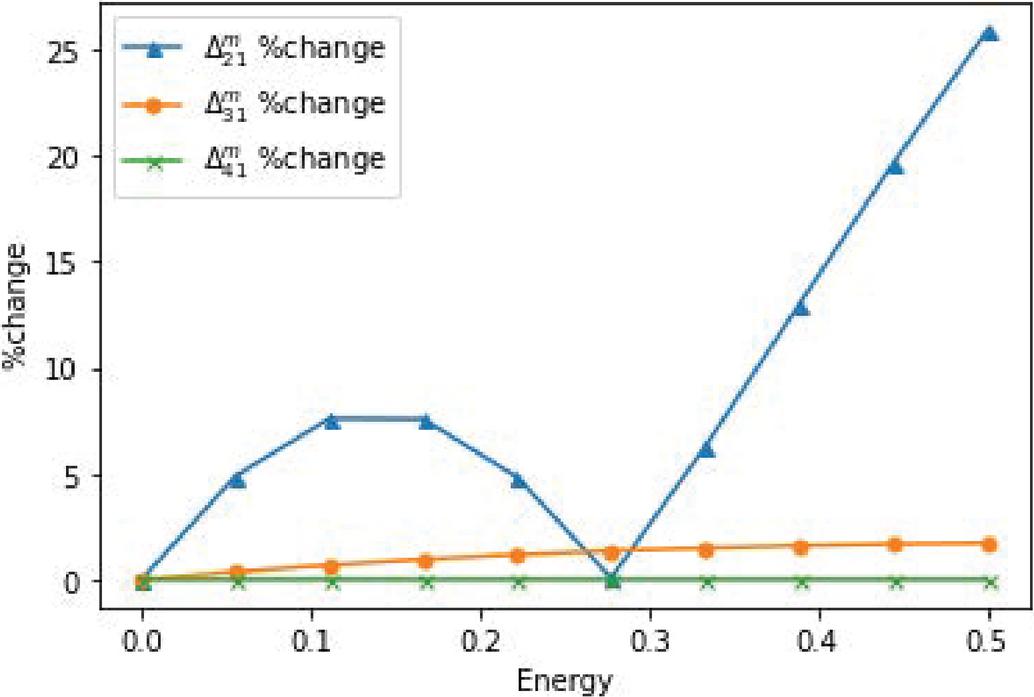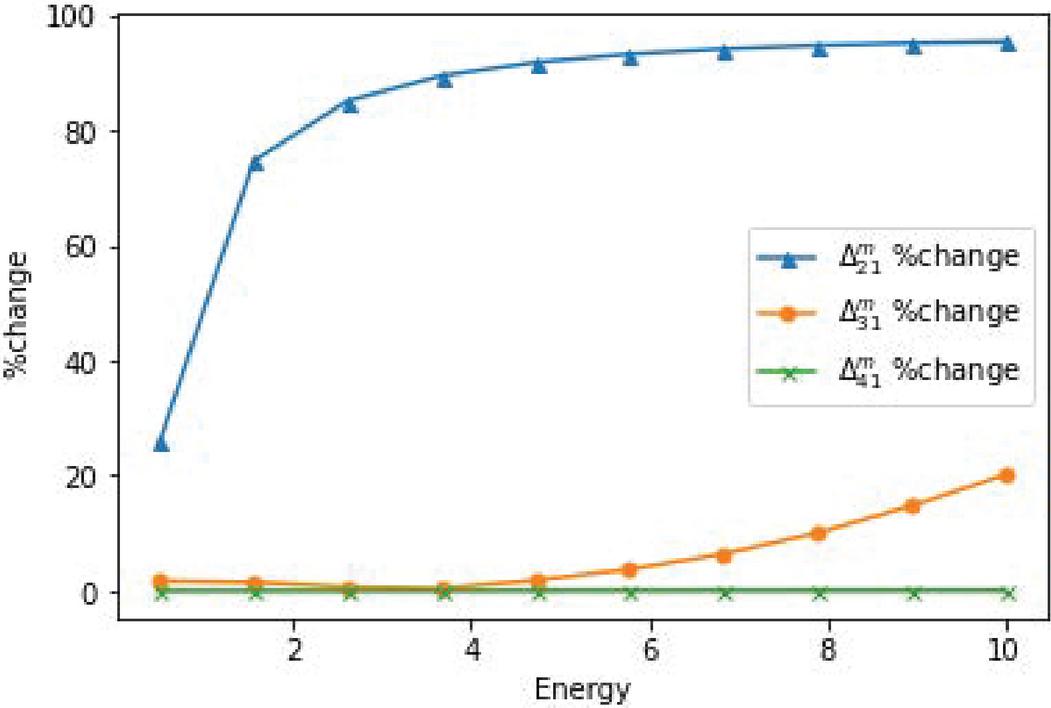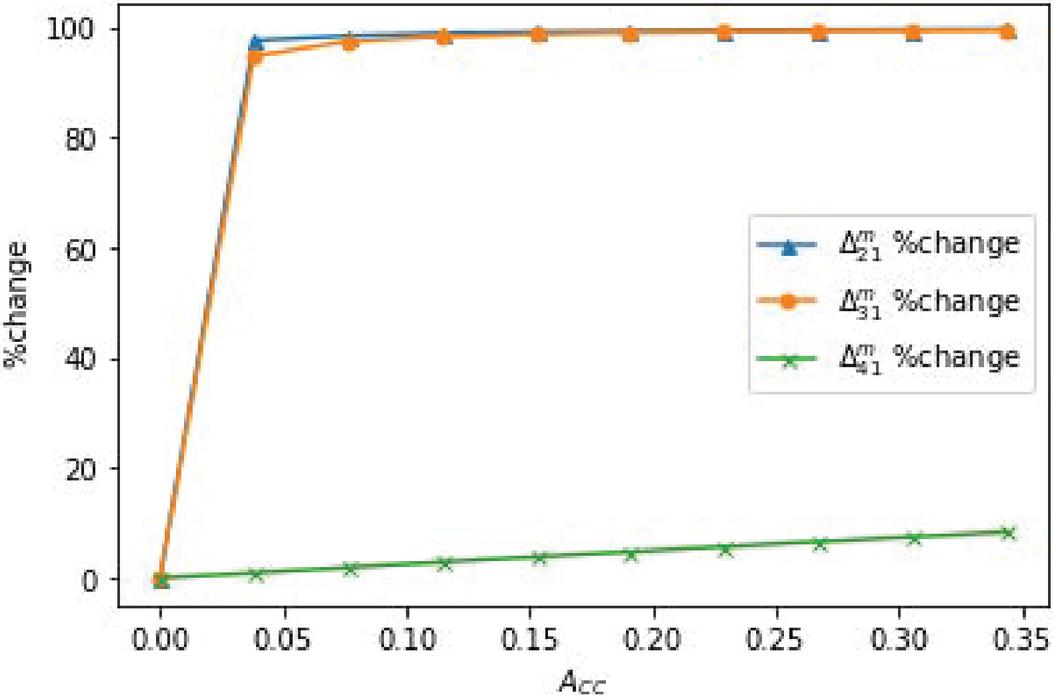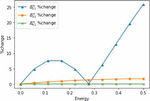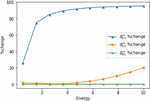Phenomenology of (3+1) Four Flavour Neutrino Oscillations in Dense Matter
Ashish Shrivastava1, Bipin Singh Koranga2,* and Seema Rawat3
1Department of Applied Physics, Delhi Technological University, Delhi-110042, India
2Department of Physics, Kirori Mal College, University of Delhi, Delhi-110007, India
3Department of Physics, Zakir Husain Delhi College, University of Delhi, Delhi-110007, India
E-mail: bskoranga@kmc.du.ac.in
*Corresponding Author
Received 11 August 2024; Accepted 03 November 2024
Abstract
The mass square difference varies as neutrinos interact with the matter, assuming four flavours of neutrino oscillations. Three regions – vacuum-dominated, resonance-dominated, and matter-dominated – are where the neutrinos oscillate. This research goes on to examine how each of these three locations affects the likelihood of neutrino oscillations and the mass square difference in distinct ways. There are three alternative analytical formulas for the mass square difference. In this study, we have studied the behaviour of neutrino oscillations for four flavours in vacuum-dominated, resonance-dominated, and matter-dominated regions.
Keywords: Four flavor neutrino oscillations, sterile neutrino, dense matter, mass square difference.
1 Introduction
With the help of the findings of numerous solar, atmospheric, accelerator, and reactor experiments [1–3], neutrino oscillation has been very well defined. Since the discovery of neutrino oscillations, the behaviour of the particles and their propensities to oscillate between various flavours have been examined. Since the mixing angle and the mass square difference affect likelihood. It was discovered that these are impacted by the matter effect, which occurs when neutrinos contact with matter. Although the precise mass of neutrinos is still unknown, multiple medium and long baseline experiments [4, 5] have provided the values of the mass square difference of various mass eigenstates and mixing angles.
The solar neutrino mass square difference measured by the LSND experiment is [6], whereas the solar mass square difference measured by the MiniBooNe experiment is [7]. This experimental finding indicated the potential for sterile (3+1) neutrinos [4, 5]. Four flavour neutrino oscillation is conceivable if sterile neutrinos are predicted to exist. When neutrinos interact with matter through neutral and charged current interactions, a rise in potential is seen, which affects the oscillation probability and mass square difference [8]. The outcomes of these interactions are determined by the neutrino energy as well as the matter density, or the concentration of electrons and neutrons in the matter. The three regions that make up the matter effect are the resonance region (also known as the MSW effect), the matter dominated region (also known as [12], and the vacuum dominated region (also known as .
2 Framework for Four-Flavor Neutrino Oscillation in Theory
Four-flavor mixing can be expressed as [9]: in terms of mass eigenstates.
where
Here, represents dirac CP violating phase.
The following can be used to represent a Hamiltonian in four flavours in a vacuum [10]
Thus the likelihood of neutrino oscillation can be expressed as [11]:
We already know that the hamiltonian changes as neutrinos go through matter because their potential increases. This increase is the result of neutral current scattering and coherent forward elastic weak charged current. Charged current scattering is caused by the interaction of an electron and neutrino pair. Consequently, the updated Hamiltonian may be written as [10]:
where
The matter terms for current charge and neutral charge, respectively, are Aand A. We will utilise the standard hierarchical approach to tackle the issue for .
2.1 Vacuum Dominated Region
As stated in the section’s headline, the matter effect in vacuum-dominated regions is small, meaning that interactions between neutrinos are insignificant and do not raise the effective potential of moving neutrinos. In light of this circumstance, we may therefore deduce the approximate values of the matter terms and .
Effective Hamiltonian can be expressed as follows from these values:
This, in vacuum, is equivalent to the Hamiltonian.
There is no such shift in mass square disparities in vacuum-dominated regions.
2.2 Resonance Region
The neutral and charge current in the resonance zone is sufficient to increase the neutrinos’ potential, which will modify their mass square difference and alter their chance of oscillations as well. The following is an example of an effective Hamiltonian for this area:
This, as a result of coherent forward elastic weak charged current and neutral current scattering, closely resembles the effective hamiltonian. You can alternatively write the above form as:
where:
Using Jacobi-Like Method [13] after the first rotation of the matrix :
Following the initial rotation of the matrix H, one can use the Jacobi-Like Method [13] to:
and
When the expressions’ defined parameters can be expressed as:
and
After the second rotation:
and
When the parameters in the expressions have the following representations:
and
So now we can say that:
and
Figure 1 Variation of relative percentage change in Mass Square difference in resonance region where energy varies from 0GeV to 0.5GeV where mixing angles are and , mass square difference in vacuum are , and and constant density .
Figure 2 Variation of relative percentage change in Mass Square difference in resonance region where energy varies from 0.5 GeV to 10 GeV where mixing angles are , , , and , mass square difference in vacuum are , and and constant density .
2.3 Matter Dominated Region()
In matter dominated region, neutrinos must be travelling in a dense matter. The condition mentioned in the heading of this section can be approximated as where . Using this condition in the expression of resonance region, the effective hamiltonian can be written as:
Neutrinos must be passing through a dense matter in an area where matter predominates. The condition given in the section’s headline can be roughly expressed as where The effective Hamiltonian can be stated as follows using this condition in the formulation of resonance region:
where:
Using a method akin to Jacobi [13]. The formulas obtained for the resonance zone will be the same for this as well, with the exception that the matrix’s parameters will change once the condition for various values of is applied. The graph below shows the variation in A for dense matter, i.e. , from less dense to very dense matter. Due to the fact that , and . The connection can be obtained from the expression . and do not affect the value of at resonance region, but at high density, the values are comparable, therefore the change in is also visible in the derived graph. This change may become saturated at larger densities, just like and .
Figure 3 Variation of relative percentage change in Mass Square difference in matter dominated region where density varies from 0 g/cc to 1500 g/cc where mixing angles are , , , and , mass square difference in vacuum are , and and constant energy .
3 Conclusions
When neutrinos interact with matter, the probabilities of neutrino oscillation and the mass square difference are affected. Only in the case of neutrinos is the normal hierarchy computation completed. The probability in vacuum-dominated regions are nearly identical to those in vacuum, and the percentage change in the relative mass square difference with regard to matter is essentially identical to those in vacuum. The effective mass square difference is growing in the resonance zone as the neutrino energy rises and the oscillation probability changes. While there are no such impacts on in this location, the percentage change in mass square difference is found to be in the range of 0 GeV to 10 GeV. However, there is a significant change in the resonance region from region 0 GeV to 0.5 GeV, followed by a harsh change in , a significant change in , as seen in the graph, and another drastic change after 3 GeV. The relative percentage change in the mass square difference with respect to the matter varies depending on whether the region is vacuum or resonance in a region where matter predominates.
Both the and alter and become saturated at about 99%. But even though the sterile neutrino only interacts with gravity, the change in has begun to rise. According to the expressions derived from the relationship between and , the extreme shift in in a dense substance that caused the effective change observed has an impact on .
References
[1] John N. Bahcall et al., Phys. Rev. Lett. 40. pp. 1351–1354, 1978.
[2] Patrick Huber, Thomas Schwetz, Phys. Lett. B 669. pp. 294–300, 2008.
[3] Zeno Dixon Greenwood et al., Phys. Rev. D 53. pp. 6054–6064, 1996.
[4] G.J. Feldman et al., Advances in High Energy Physics, Vol. 2013, pp. 1–30, 2013-01, 2013.
[5] Chiaki Yanagisawa et al., Phys. Rev. D 83, pp. 072002, 2011.
[6] G. Conforto et al., Phys. Lett. B 447, pp. 122–126, 1999.
[7] MiniBoone Collaboration, A.A. Aguilar-Arevalo et al., Phys. Rev D 103, pp. 1–5, 2021.
[8] A. Yu. Smirnov, Phys. Scripta T 121, pp. 57–64, 2005.
[9] B. S. Koranga et al., Int. J. Theor. Phys. 60, 9 pp. 3548–3565, 2021.
[10] Ashish Shrivastava, B. S. Koranga et al., arxiv:2106.15945 (hep-ph).
[11] S. Dev et al., Nuclear. Phys B 491, pp. 401, 2019.
[12] S. Luo et al., Moscow Univ. Phys. Bull. 77 pp. 462–463, 2022.
[13] Bao-Biao Yue, Jia-Jie Ling et al., Chin. Phys. C 44, 10 pp. 103001, 2020.
Biographies
Ashish Shrivastava is a post graduate student in the Department of Applied Physics, Delhi Technological University. He is in the final year of M.Sc. Physics. He received his bachelor’s degree from Kirori Mal College, University of Delhi in Physical Science. He completed his dissertation in Phenomenology of Neutrino Oscillations during his under graduation. His work has been published in Journal of Graphic Era along with the conference. He is currently working on a project in which he is studying Quantum Entanglement in Neutrino Oscillations.
Bipin Singh Koranga is Professor in the Department of Physics, Kirorimal College, University of Delhi. He joined the Theoretical Physics Group at the Indian Institute of Technology Bombay in 2006 and earned his Ph.D. in physics (neutrino masses and mixings) there in 2007. For the past 17 years, he has been instructing graduate-level students in foundational physics and mathematical physics courses. The genesis of the cosmos, physics beyond the standard model, theoretical nuclear physics, quantum mechanical neutrino oscillation, and a few astrological issues are among his areas of interest. He has more than 60 scientific publications to his credit in different international journals. His current areas of focus in study are linked phenomenology and neutrino mass theories.
Seema Rawat is an Associate Professor of physics at Zakir Husain College, University of Delhi, where she has taught Quantum mechanics and Theortical Physics to undergraduate students. He received his master’s degree in physics from Kumaun University Nainital and doctoral degree in physics from Kumaun University Nainital. He has more than 30 scientific publications to his credit in different international journals. His current areas of focus in high energy particle physics.
Journal of Graphic Era University, Vol. 12_2, 363–372.
doi: 10.13052/jgeu0975-1416.12210
© 2024 River Publishers
